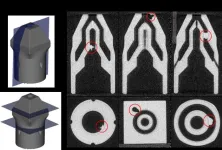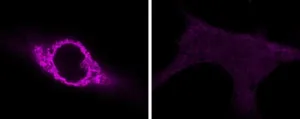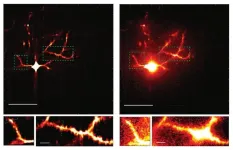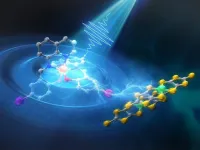(Press-News.org) Researchers at the University of São Paulo (USP) in Brazil have shown for the first time that SARS-CoV-2, the virus that causes COVID-19, can remain in the sperm of patients for up to 90 days after hospital discharge and up to 110 days after the initial infection, reducing semen quality. The study is reported in an article published in the journal Andrology. The authors suggest that people who plan to have children should observe a period of “quarantine” after recovering from COVID-19.
More than four years after the start of the pandemic, we know SARS-CoV-2 is able to invade and destroy several types of human cells and tissue, including the reproductive system, where the testicles serve as a “gateway”. Although scientists have noted that the virus is more aggressive than other viruses toward the male genital tract, and autopsies have found it in testicles, it has rarely been detected in semen by polymerase chain reaction (PCR) analysis, which focuses on viral DNA.
To fill this knowledge gap, the study – which was supported by FAPESP – used real-time PCR and transmission electronic microscopy (TEM) to detect viral RNA in semen and spermatozoa donated by men who were convalescing from COVID-19.
The semen samples were taken from 13 patients aged between 21 and 50 who had had mild, moderate and severe COVID-19 and had been admitted to Hospital das Clínicas (HC), the hospital complex run by the university’s medical school (FM-USP). The analysis was conducted up to 90 days after discharge and 110 days after diagnosis. Although the PCR test results were negative for SARS-CoV-2 in semen in all cases, the virus was detected in sperm from eight of 11 moderate to severe COVID-19 patients (72.7%) within 90 days of discharge, which does not mean it was not present for longer, according to the authors.
SARS-CoV-2 was also detected in one of the mild COVID-19 patients. In sum, the virus was detected in sperm from nine of the 13 patients (69.2%). Two others had ultrastructural gamete impairment similar to that seen in patients with a COVID-19 diagnosis. The authors therefore concluded that 11 of the patients had the virus in their sperm.
“Moreover, we found that the sperm produced ‘extracellular traps’ based on nuclear DNA. In other words, genetic material in the nucleus decondensed, the sperms’ cell membranes ruptured, and the DNA was expelled into the extracellular medium, forming networks similar to those described previously in the systemic inflammatory response to SARS-CoV-2,” said Jorge Hallak, a professor at FM-USP and corresponding author of the article.
The networks in question are neutrophil extracellular traps (NETs). Neutrophils, a type of white blood cell, form the first line of the immune system, immobilizing and killing pathogenic bacteria, fungi and viruses. When hyperactive, however, NETs can harm tissue elsewhere in the organism (read more at: agencia.fapesp.br/33523).
TEM analysis showed that the sperm produced extracellular traps based on nuclear DNA to neutralize the pathogen, “sacrificing themselves” to contain the pathogen in a mechanism known as a suicidal ETosis-like response (ETosis meaning death via extracellular traps).
“The finding that spermatozoa are part of the innate immune system and help defend the organism against attack by pathogens is unique in the literature and makes the study very important. It can be considered a scientific paradigm shift,” Hallak said.
Until now, he added, sperm were known to have four functions: binding the genetic contents of male gametes to female gametes, fertilizing female gametes, promoting embryo development until the twelfth week of pregnancy, and co-determining the development of certain chronic diseases in adulthood, such as infertility, hypogonadism, diabetes, hypertension, some types of cancer, and cardiovascular disorders, among others.
The discovery described in the study adds a novel function to their role in reproduction. “The possible implications of our findings for the use of sperm in assisted reproduction should be urgently considered by physicians and regulators, especially with regard to the technique used by Brazilian laboratories that perform gamete micromanipulation in more than 90% of cases of conjugal infertility, which involves the injection of a single spermatozoon into the egg and is known as intracytoplasmic sperm injection, or ICSI,” Hallak said.
Hallak advocates postponement of natural conception and particularly of assisted reproduction for at least six months after infection by SARS-CoV-2, even if mild COVID-19 ensues.
Previous discoveries
Hallak was one of the first members of the scientific and medical communities to suggest more caution in reproduction protocols during the pandemic. He has studied the impact of COVID-19 on reproductive and sexual health since 2020, when he volunteered on the front line as an emergency room physician at HC-FM-USP.
His research group, which includes colleagues in FM-USP’s Department of Pathology, has already made important discoveries in the field, such as the higher risk of severe COVID-19 infection and death from the disease for men simply because of their sex, possibly because of the abundance of ACE2 receptors and TMPRSS2 in testes, whereas ovaries have only ACE2 receptors. The virus uses ACE2 to invade cells; TMPRSS2 is a protein that enables the virus to bind to ACE2 on the cell surface.
In a study conducted with members of HC-FM-USP’s Clinical Urology Division, the group found that health workers experienced a sharp drop in libido and sexual satisfaction, as well as increased consumption of pornography and more frequent masturbation, due to the pandemic.
The group also discovered that the testes are potential targets for infection by the virus, which causes subclinical epididymitis (inflammation of the epididymis, a narrow tube attached to each testicle that stores, matures and transports sperm cells), and showed for the first time the severity of the testicular lesions associated with COVID-19.
The group of physicians and scientists at HC-FM-USP, led by Professor Carlos Carvalho, is currently investigating the lagging effects of infection by SARS-CoV-2 in more than 700 patients originally assessed for a Thematic Project funded by FAPESP.
About São Paulo Research Foundation (FAPESP)
The São Paulo Research Foundation (FAPESP) is a public institution with the mission of supporting scientific research in all fields of knowledge by awarding scholarships, fellowships and grants to investigators linked with higher education and research institutions in the State of São Paulo, Brazil. FAPESP is aware that the very best research can only be done by working with the best researchers internationally. Therefore, it has established partnerships with funding agencies, higher education, private companies, and research organizations in other countries known for the quality of their research and has been encouraging scientists funded by its grants to further develop their international collaboration. You can learn more about FAPESP at www.fapesp.br/en and visit FAPESP news agency at www.agencia.fapesp.br/en to keep updated with the latest scientific breakthroughs FAPESP helps achieve through its many programs, awards and research centers. You may also subscribe to FAPESP news agency at http://agencia.fapesp.br/subscribe.
END
Virus that causes COVID-19 can remain in sperm for 110 days after infection
Researchers detected SARS-CoV-2 in male reproductive cells under the microscope even when PCR testing failed to detect the virus in semen. The discovery serves as a warning of possible implications for natural conception and for assisted reproduction
2024-06-04
ELSE PRESS RELEASES FROM THIS DATE:
Researchers use machine learning to detect defects in additive manufacturing
2024-06-04
Researchers at the University of Illinois Urbana-Champaign have developed a new method for detecting defects in additively manufactured components.
One of the most important tasks in any factory is to determine whether a manufactured component is free of defects. In additive manufacturing (3D printing), it can be particularly challenging to find defects, because additive manufacturing can make components that have complex three-dimensional shapes and important internal features that are not easily observed.
The novel technology uses deep machine ...
Rare disease’s DNA-damaging mutation could have consequences for more common conditions
2024-06-04
TREX1 is a gene that is supposed to direct the maintenance of the entire body’s DNA, but new research shows that when people are born with mutated TREX1, it causes catastrophic damage to the DNA over time, resulting in a deadly rare disease called retinal vasculopathy with cerebral leukoencephalopathy (RVCL). Published in Nature Communications, the research was led by teams at the Perelman School of Medicine at the University of Pennsylvania and the Brain Research Institute at Niigata University in Japan.
While it was already known that a mutation in TREX1 was behind RVCL, the mechanism by which ...
Exploring three frontiers in marine biomass and blue carbon capture
2024-06-04
A new study offers first-time insights into three emerging climate innovations to safeguard or increase the carbon naturally captured by ocean and coastal ecosystems: rapid interventions to save the Great Barrier Reef, satellite-tracked kelp beds in the deep ocean, and seagrass nurseries in the United Kingdom. The research, published in Environmental Science & Policy and co-authored by leading climate scholars at Boston University, Aarhus University, and the University of Sussex Business School, advances knowledge of understudied interventions in marine ...
Microscope system sharpens scientists’ view of neural circuit connections
2024-06-04
The brain’s ability to learn comes from “plasticity,” in which neurons constantly edit and remodel the tiny connections called synapses that they make with other neurons to form circuits. To study plasticity, neuroscientists seek to track it at high resolution across whole cells, but plasticity doesn’t wait for slow microscopes to keep pace and brain tissue is notorious for scattering light and making images fuzzy. In a paper in Scientific Reports, a collaboration of MIT engineers and neuroscientists describes a new microscopy system designed for fast, clear, and frequent imaging of the living brain.
The system, ...
VHIO researchers demonstrate the utility of high-sensitivity liquid biopsy to predict and monitor response to immunotherapy
2024-06-04
The liquid biopsy technique applied in this work is based on the sequencing of the entire tumor genome from 138 patients and the monitoring of mutations in the blood. This approach achieves high sensitivity in detecting the tumor signal in the blood (1/1,000,000 DNA molecules), and the patterns found reflect how patients respond to immunotherapy.
This study is part of the Comprehensive Program of Cancer Immunotherapy and Immunology (CAIMI) at VHIO, funded by the BBVA Foundation, and is co-led by Dr Rodrigo Toledo, head of the Biomarkers and Clonal Dynamics Group at the Vall d’Hebron Institute of Oncology (VHIO), ...
Muscle disorder caused by key protein mutations uncovered in new study
2024-06-04
A recent study has found that the SMCHD1 protein plays a key role in controlling how genes are processed, which affects the progression of Facioscapulohumeral Muscular Dystrophy (FSHD). This discovery about SMCHD1's function in gene regulation is important because it opens new possibilities for developing targeted therapeutic strategies to combat the disease. By understanding more about how SMCHD1 works, scientists can explore new ways to fight the disease.
A recent study by MD-PhD student Eden Engal under the guidance of Dr. Yotam Drier and ...
Observing ultrafast photoinduced dynamics in a halogen-bonded supramolecular system
2024-06-04
Researchers uncover how the halogen bond can be exploited to direct sequential dynamics in the multi-functional crystals, offering crucial insights for developing ultrafast-response times for multilevel optical storage.
Halogen bonds are intermolecular interactions that arise from the attraction between a halogen atom (group 17 elements in the periodic table) and another atom with lone pairs, more generally a molecular entity with high electron density. Understanding the distinctive and highly directional nature of halogen bonds is crucial for crystal engineering and studying ...
USPSTF recommendation statement on interventions to prevent falls in community-dwelling older adults
2024-06-04
Bottom Line: The U.S. Preventive Services Task Force (USPSTF) recommends exercise interventions to prevent falls in community-dwelling adults 65 years or older who are at increased risk for falls. The USPSTF recommends that clinicians individualize the decision to offer multifactorial interventions to prevent falls to community-dwelling adults 65 years or older who are at increased risk for falls. Existing evidence indicates that the overall net benefit of routinely offering multifactorial interventions to prevent falls is small. When determining ...
ASCO: Proton therapy demonstrates advantages in Phase III head and neck cancer trial
2024-06-04
ABSTRACT 6006
CHICAGO ― According to preliminary data from a multi-institution Phase III trial led by researchers at The University of Texas MD Anderson Cancer Center, intensity modulated proton therapy (IMPT) achieved similar clinical outcomes and offered significant patient benefits when compared to traditional intensity modulated radiation therapy (IMRT) as part of chemoradiation treatment for patients with oropharyngeal (head and neck) cancer.
The results were presented today at the 2024 American Society of Clinical Oncology (ASCO) Annual Meeting by Steven Frank, M.D., professor of Radiation Oncology and executive director of the Particle ...
Mapping lava flows with groundbreaking field instrument
2024-06-04
WASHINGTON, June 4, 2024 – Millions of people live near active volcanoes that are constantly monitored for signs of an impending eruption. When one occurs, scientists and governments rely on data to estimate the extent of the possible damage, informing evacuation plans and disaster response efforts. The nature of eruptions, unfortunately, means collecting data about them can sometimes be as challenging as organizing a response.
In Review of Scientific Instruments, by AIP Publishing, researchers from the University at Buffalo developed a tool for measuring the viscosity of lava that could increase our understanding of molten rock as well as better improve ...
LAST 30 PRESS RELEASES:
Injectable breast ‘implant’ offers alternative to traditional surgeries
Neuroscientists devise formulas to measure multilingualism
New prostate cancer trial seeks to reduce toxicity without sacrificing efficacy
Geometry shapes life
A CRISPR screen reveals many previously unrecognized genes required for brain development and a new neurodevelopmental disorder
Hot flush treatment has anti-breast cancer activity, study finds
Securing AI systems against growing cybersecurity threats
Longest observation of an active solar region
Why nail-biting, procrastination and other self-sabotaging behaviors are rooted in survival instincts
Regional variations in mechanical properties of porcine leptomeninges
Artificial empathy in therapy and healthcare: advancements in interpersonal interaction technologies
Why some brains switch gears more efficiently than others
UVA’s Jundong Li wins ICDM’S 2025 Tao Li Award for data mining, machine learning
UVA’s low-power, high-performance computer power player Mircea Stan earns National Academy of Inventors fellowship
Not playing by the rules: USU researcher explores filamentous algae dynamics in rivers
Do our body clocks influence our risk of dementia?
Anthropologists offer new evidence of bipedalism in long-debated fossil discovery
Safer receipt paper from wood
Dosage-sensitive genes suggest no whole-genome duplications in ancestral angiosperm
First ancient human herpesvirus genomes document their deep history with humans
Why Some Bacteria Survive Antibiotics and How to Stop Them - New study reveals that bacteria can survive antibiotic treatment through two fundamentally different “shutdown modes”
UCLA study links scar healing to dangerous placenta condition
CHANGE-seq-BE finds off-target changes in the genome from base editors
The Journal of Nuclear Medicine Ahead-of-Print Tip Sheet: January 2, 2026
Delayed or absent first dose of measles, mumps, and rubella vaccination
Trends in US preterm birth rates by household income and race and ethnicity
Study identifies potential biomarker linked to progression and brain inflammation in multiple sclerosis
Many mothers in Norway do not show up for postnatal check-ups
Researchers want to find out why quick clay is so unstable
Superradiant spins show teamwork at the quantum scale
[Press-News.org] Virus that causes COVID-19 can remain in sperm for 110 days after infectionResearchers detected SARS-CoV-2 in male reproductive cells under the microscope even when PCR testing failed to detect the virus in semen. The discovery serves as a warning of possible implications for natural conception and for assisted reproduction





